|
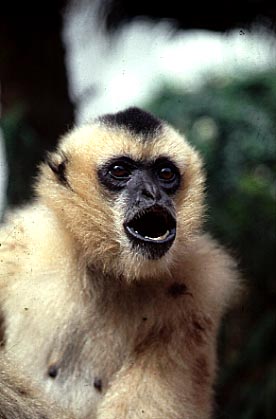 |
by Mick Shippen
|
 |
|
|
Holger was feeling a little overwhelmed by all the attention. A new face in the house made him unsure of
things and he clung tightly to a bright-red security blanket. When this failed
to offer the required reassurance he plunged a familiar thumb into his mouth…
and sucked. Being fully experienced in the ways of infants and in an attempt to
gain the young ones trust I resorted to smiles and sweet-talk. The reward for my
patience was an outstretched leg and a small leathery foot thrust bravely into
my hand, the toes curling tightly around welcoming fingers. Such a simple
gesture but one not easily forgotten. |
Holger, of course, is no
ordinary youngster but a concolor gibbon. Now a charismatic and intelligent
two-year old, he was originally rejected at birth by his captive parents.
Welcomed with open arms by Pharanee and William Deters, and now one of over
thirty gibbons in their care, home for young Holger is Highland Farm just
outside Mae Sot in Tak Province.
Known in Thai as the Cha-nee,
the first frightened and injured baby gibbon was brought to their door in 1991.
In this particular case a hunter had shot the mother, and the orphan - later
named Chester - who was deemed as having no value because of his injuries, was
given to the Deters.
Relocating to Mae Sot from
the USA, the Thai – American couple where looking forward to a quiet and
well-earned retirement but Chester changed all that. As the surrogate parents
struggled to find out information about the habitat and behavior of gibbons it
soon became apparent that the tragic fate of Chester’s mother was an
all-too-familiar story.
‘Hunters pose one of the
greatest threats to the gibbon population in Thailand, indeed in Southeast Asia.
Mothers are frequently shot so that they can take the baby away. The youngsters
are then sold as pets or used as an attraction in a bar,’ explained William.
It is widely believed that
for every baby gibbon captured by hunters another two youngsters and three
parents have died in the process.
Resort towns such as
Pattaya are common haunts for gibbons and their tormentors. Despite the fact
that hunting and trading gibbons in Thailand is illegal, the law seems unable or
unwilling to tackle the problem. Complacency and acceptance on behalf of a
general public all too willing to hand over a few baht to be photographed with a
distressed or drugged animal, certainly doesn’t help the situation.
Although it is easy to see
the allure of a baby gibbon it is, however, a wild animal and as they mature -
at about four years of age - they become aggressive and unpredictable. The
result inevitably is confinement or rejection by the owners.
Once the scale of the
problem became known to the Deters it was impossible for them to stand idly by.
‘Almost without question
we decided to commit the rest of our lives to caring for the gibbons’, added
William.
Most of the magnificent
primates that they care for have one thing in common; they are victims of
neglect and abuse at the hands of man. Take Denny, for example, who was kept by
her owner in a wooden box just sixty cm square. She was discovered in a pitiful
condition, almost hairless and suffering from wasted muscles.
|
|
Mimi is another tragic case
whose life was typical of many captive gibbons. When not confined to a cage she
was led around the streets of Bangkok to be photographed for money. William
explained her story |
‘She climbed up a pole in
the city and grabbed hold of an electric cable. The resulting burns to her left
forearm and lower left leg were so severe that they had to be amputated. She
also lost the sight in one eye.’
No longer of any use to the
owner, Mimi was discarded. The Deters trip to Bangkok to rescue her also brought
news of another young gibbon named Jerry. Unable to leave this victim of
brutality with his keeper, William and Pharanee returned with Jerry too.
‘The owner, a military
man, kicked him so hard that he suffered terrible hip and spinal injuries’,
said Pharanee.
It is a sad irony but due
to such maltreatment and long periods of confinement the gibbons are now totally
dependent on man. At Highland Farm however they are offered a safe haven and
unconditional love - a place to escape the cruelty. Walking around the
enclosures of the thirty-five acre property William told the life history of
each ape, of the sorry state they were in when they arrived and how they have
responded to treatment. Although no cure for the physical scars, the love and
devotion that they give to the gibbons has gone some way to heal the deep
emotional wounds.
An insight into the Deters
generosity of spirit and deep attachment to the animals can be gained from an
entry in William’s diary, in which he says,
‘A new member of the
sanctuary family is Kerrie, a seven-year-old concolor girl severely crippled
from polio. Her legs are useless, as are the fingers of one hand. Most of her
hair is gone …in six months she should be a beauty’.
|
|
|
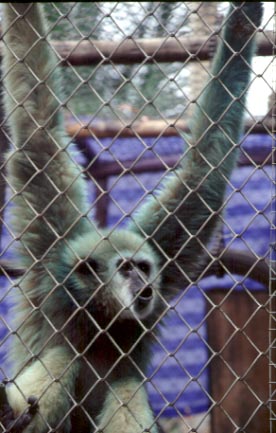 |
A major factor in the
seemingly endless supply of orphaned gibbons is the continued destruction of
their natural habitat. A truly arboreal creature and perhaps one of the
world’s greatest acrobats the gibbon has little chance of survival if current
levels of deforestation and human encroachment continue. Inhabiting the upper
canopy of the forest, the gibbon’s aerial artistry is nothing short of
spectacular. Capable of leaping gaps of over ten meters while traveling at great
speed, this shy and reclusive creature is a threat to no one. Yet in Southeast
Asia the gibbon has been hit harder than any other primate has. A visit to the
Myanmar border market of Tachileik opposite Mae Sai, where stall-holders openly
(and seemingly without any sense of shame) sell the skulls of gibbons and other
primates, serves as a grisly reminder that time is running out if we are to save
these fabulous creatures. Although no primates have become extinct within the
last 100 years scientists believe that about twenty percent of them face that
prospect over the next twenty years. The gibbon is one of them. Of the nine
species worldwide, all are seriously endangered.
‘Only last week we
rescued a five year-old gibbon that was being kept caged by the Forestry
Department. It was on display at the entrance to Tam Lod Cave in Mae Hong Song
province’ said William.
Clearly distressed and
tormented by visitors the animal had bitten many a finger and was living a
miserable existence in cramped and dirty conditions. An inadequate diet and
soiled water had seriously affected his health. Despite this the Forestry
Department was reluctant to let the Deters take him away and it took much
persuasion and patience before permission was eventually granted.
Pharanee commented, ‘One
of the most distressing things for the gibbon was the fact that the rest of his
family were still living in the surrounding hills but all he could do was call
to them. At Highland Farm he’ll be in close contact with other gibbons.’
Such distress in tangible
when you consider that the intense bond formed between mother and child lasts
for over ten years. Not only do the parent’s pair for life but they also share
responsibility for raising the offspring.
Twenty miles from Tam Lod
another baby gibbon is currently being kept at a shop. William and Pharanee hope
to rescue it soon but such negotiations often prove difficult, as the first
thing on the owner’s mind is usual money. The Deters, however, refuse to buy
the youngsters believing that such actions merely fuel the trade. Initial talks
with the owner were enlightening.
‘She was only in her
‘late thirties’ but recalled that as a teenager, every morning, the hillside
opposite her shop was bursting with the ‘whooping’ sound of gibbon song. Now
all is silent and it is likely that the baby in her shop is the only one in the
immediate area. Most of the others will have either been killed or captured. A
few lucky ones may have moved deeper into the forest away from man’, said
William.
Highland Farm was quick to
recognize the importance of education in the struggle to improve the current
situation and embarked on a number of programs to help address the problems.
Raising public awareness of the gibbons’ plight is seen as paramount to
bringing a halt to the trade in youngsters.
‘Getting people to
understand the cruelty involved, and to resist the temptation to buy a baby or
give money to be photographed with one, is essential. We need to take the price
off the head of the youngsters and in that respect everyone has a part to play
in saving the gibbon. Loosing that fight will mean that one-day Thailand’s
entire gibbon population will be viewed through the bars of a cage. That is a
high price to pay and a very sad prospect’, says Pharanee.
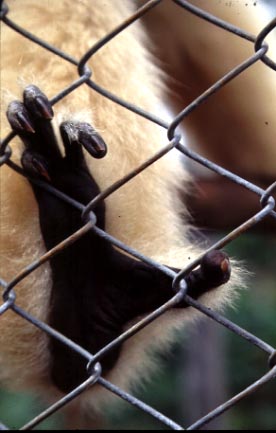 |
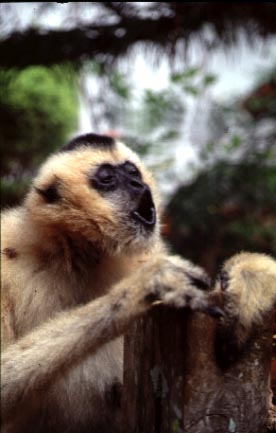 |
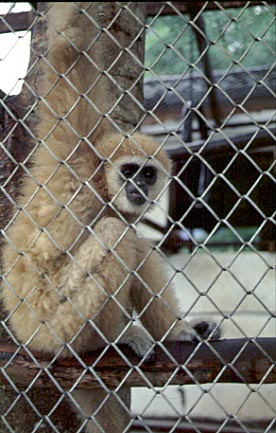 |
Since Chester came into
their lives nine years ago over 14,000 visitors and school children have come
through the farm to learn about the gibbons. None can fail to be touched by the
experience.
For those who are
interested in serious research into gibbon behavior the Deters also allow
students and professionals to stay and study at the farm. There is also an
Adopt-a-Gibbon scheme. All these programs are designed not only to increase
understanding but also to raise much-needed funds.
‘Highland Farm is a
private concern and we rely on our own finances to keep the place going. The
generous contributions of volunteers and guests are always welcome and play an
important part in the continual development of the sanctuary’, explained
Pharanee.
It’s a task that cannot
be taken lightly. Each year the number of gibbons in their care increases and
with an average life span of forty years, plans for the future are essential.
Yet despite their heroic efforts and undeniable commitment, the Deters are only
picking up the pieces thoughtlessly dropped and ignored by a society that seems
to care little about its indigenous species. The real battle is to win the
hearts and minds of a nation.
William added thoughtfully,
‘Often described as the
songbird of the primates because of a beautifully musical call that resonates
through the treetops for well over a kilometer, the gibbon has made its way into
Thai mythology. For the forests of Thailand to fall silent and for the gibbon to
be condemned to the pages of a storybook would be a tragedy heard all over the
world’.
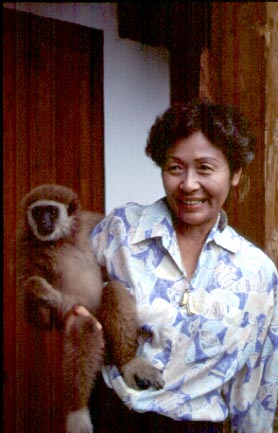 |
|
Info for donations.
Highland Farm and Gibbon
Sanctuary, Km.42.8, Route 1090, Tambol Chong Kab, Amphur Prop Pra, Tak 63160.
email highland_ape@hotmail.com
All donations are
gratefully accepted and for a monthly fee of $5 US you can join the ‘Adopt-a-
Gibbon’ scheme.
Cheques and money orders
payable to Highland Ape, C/O Krung Thai Bank, Mae Sot Branch, Tak, 63110.
Savings Account no. 604-1-41229-5.
For more details visit the web site www.members.tripod.com/highlandfarm/
***************************************
FINIS